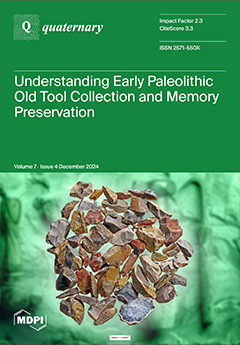Quaternary stream sediments and beach black sand in north-western Saudi Arabia (namely Wadi Thalbah, Wadi Haramil and Wadi Al Miyah) are characterized by the enrichment of heavy minerals. Concentrates of the heavy minerals in two size fractions (63–125 μm and 125–250 μm) are considered as potential sources of “strategic” accessory minerals. A combination of mineralogical, geochemical and spectroscopic data of opaque and non-opaque minerals is utilized as clues for provenance. ThO
2 (up to 17.46 wt%) is correlated with UO
2 (up to 7.18 wt%), indicating a possible uranothorite solid solution in zircon. Hafnoan zircon (3.6–5.75 wt% HfO
2) is a provenance indicator that indicates a granitic source, mostly highly fractionated granite. In addition, monazite characterizes the same felsic provenance with rare-earth element oxides (La, Ce, Nd and Sm amounting) up to 67.88 wt%. These contents of radionuclides and rare-earth elements assigned the investigated zircon and monazite as “strategic” minerals. In the bulk black sand, V
2O
5 (up to 0.36 wt%) and ZrO
2 (0.57 wt%) are correlated with percentages of magnetite and zircon. Skeletal or star-shaped Ti-magnetite is derived from the basaltic flows. Mn-bearing ilmenite, with up to 5.5 wt% MnO, is derived from the metasediments. The Fourier-transform infrared transmittance (FTIR) spectra indicate lattice vibrational modes of non-opaque silicate heavy minerals, e.g., amphiboles. In addition, the FTIR spectra show O-H vibrational stretching that is related to magnetite and Fe-oxyhydroxides, particularly in the magnetic fraction. Raman data indicate a Verwey transition in the spectrum of magnetite, which is partially replaced by possible ferrite/wüstite during the measurements. The Raman shifts at 223 cm
−1 and 460 cm
−1 indicate O-Ti-O symmetric stretching vibration and asymmetric stretching vibration of Fe-O bonding in the FeO
6 octahedra, respectively. The ultraviolet-visible-near infrared (UV-Vis-NIR) spectra confirm the dominance of ferric iron (Fe
3+) as well as some Si
4+ transitions of magnetite (226 and 280 nm) in the opaque-rich fractions. Non-opaque heavy silicates such as hornblende and ferrohornblende are responsible for the 192 nm intensity band.
Full article





